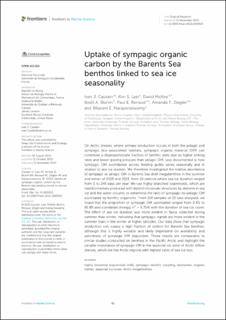| dc.contributor.author | Cautain, Ivan J. | |
| dc.contributor.author | Last, Kim S. | |
| dc.contributor.author | Mckee, David | |
| dc.contributor.author | Bluhm, Bodil | |
| dc.contributor.author | Renaud, Paul Eric | |
| dc.contributor.author | Ziegler, Amanda | |
| dc.contributor.author | Narayanaswamy, Bhavani E. | |
| dc.date.accessioned | 2023-01-12T13:00:03Z | |
| dc.date.available | 2023-01-12T13:00:03Z | |
| dc.date.created | 2022-12-13T14:19:30Z | |
| dc.date.issued | 2022 | |
| dc.identifier.citation | Frontiers in Marine Science. 2022, 9 . | en_US |
| dc.identifier.issn | 2296-7745 | |
| dc.identifier.uri | https://hdl.handle.net/11250/3043074 | |
| dc.description.abstract | On Arctic shelves, where primary production occurs in both the pelagic and sympagic (ice-associated) habitats, sympagic organic material (OM) can constitute a disproportionate fraction of benthic diets due to higher sinking rates and lower grazing pressure than pelagic OM. Less documented is how sympagic OM assimilation across feeding guilds varies seasonally and in relation to sea ice duation. We therefore investigated the relative abundance of sympagic vs pelagic OM in Barents Sea shelf megabenthos in the summer and winter of 2018 and 2019, from 10 stations where sea ice duration ranged from 0 to 245 days per year. We use highly branched isoprenoids, which are lipid biomarkers produced with distinct molecular structures by diatoms in sea ice and the water column, to determine the ratio of sympagic-to-pelagic OM assimilated by benthic organisms. From 114 samples of 25 taxa analysed, we found that the proportion of sympagic OM assimilated ranged from 0.4% to 95.8% and correlated strongly (r2 = 0.754) with the duration of sea ice cover. The effect of sea ice duration was more evident in fauna collected during summer than winter, indicating that sympagic signals are more evident in the summer than in the winter at higher latitudes. Our data show that sympagic production can supply a high fraction of carbon for Barents Sea benthos, although this is highly variable and likely dependent on availability and patchiness of sympagic OM deposition. These results are comparable to similar studies conducted on benthos in the Pacific Arctic and highlight the variable importance of sympagic OM in the seasonal ice zone of Arctic inflow shelves, which are the Arctic regions with highest rates of sea ice loss. | en_US |
| dc.language.iso | eng | en_US |
| dc.title | Uptake of sympagic organic carbon by the Barents Sea benthos linked to sea ice seasonality | en_US |
| dc.title.alternative | Uptake of sympagic organic carbon by the Barents Sea benthos linked to sea ice seasonality | en_US |
| dc.type | Peer reviewed | en_US |
| dc.type | Journal article | en_US |
| dc.description.version | publishedVersion | en_US |
| dc.source.pagenumber | 14 | en_US |
| dc.source.volume | 9 | en_US |
| dc.source.journal | Frontiers in Marine Science | en_US |
| dc.identifier.doi | 10.3389/fmars.2022.1009303 | |
| dc.identifier.cristin | 2092608 | |
| cristin.ispublished | true | |
| cristin.fulltext | original | |
| cristin.qualitycode | 1 | |
